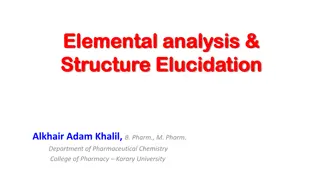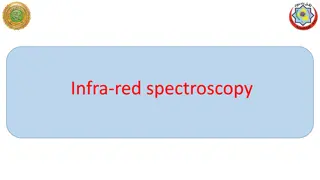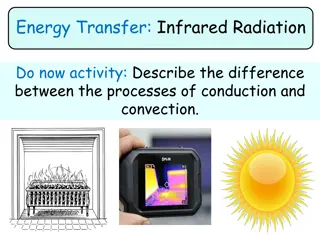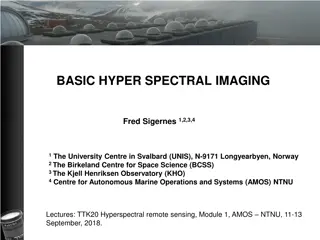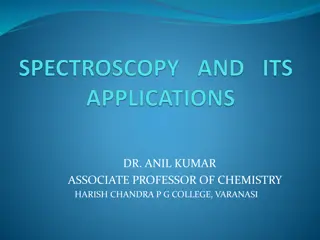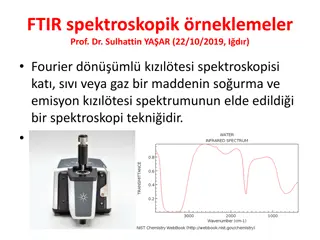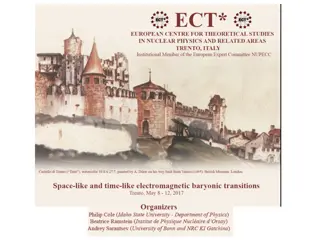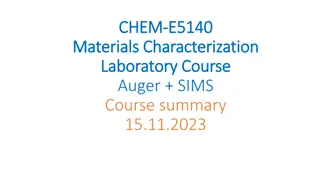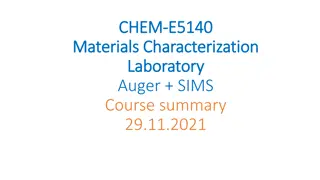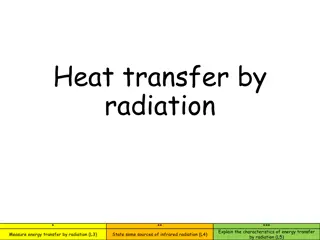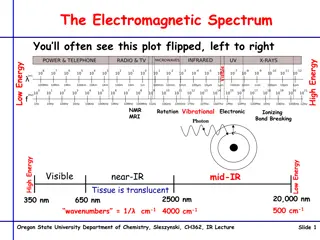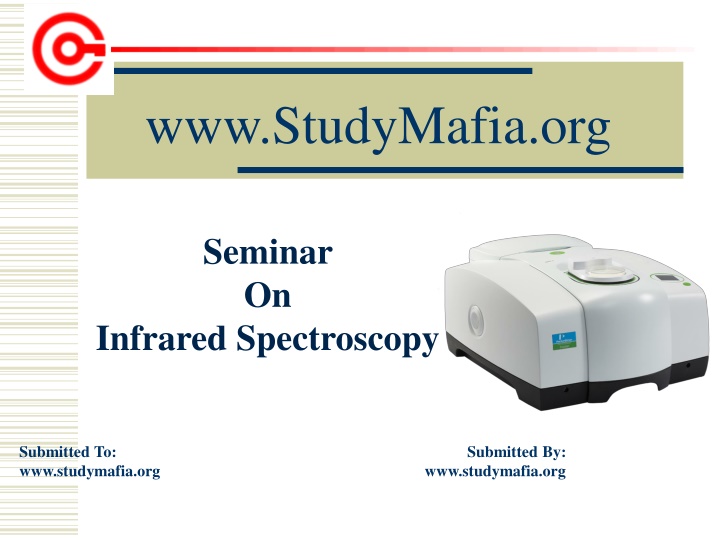
Infrared Spectroscopy: Theory, Applications, and Benefits
Explore the theory and principles behind infrared spectroscopy, a valuable technique for analyzing organic and organometallic molecules. Learn about the process, advantages, and limitations, as well as practical examples of IR applications.
Download Presentation

Please find below an Image/Link to download the presentation.
The content on the website is provided AS IS for your information and personal use only. It may not be sold, licensed, or shared on other websites without obtaining consent from the author. If you encounter any issues during the download, it is possible that the publisher has removed the file from their server.
You are allowed to download the files provided on this website for personal or commercial use, subject to the condition that they are used lawfully. All files are the property of their respective owners.
The content on the website is provided AS IS for your information and personal use only. It may not be sold, licensed, or shared on other websites without obtaining consent from the author.
E N D
Presentation Transcript
www.StudyMafia.org Seminar On Infrared Spectroscopy Submitted To: www.studymafia.org www.studymafia.org Submitted By:
Table Of Content What is Infrared Spectroscopy? IR Spectroscopic Process Example OF IR Theory of Infrared Absorption Spectroscopy Uses and Application Advantages Disadvantages Conclusion Reference
Definition of Infrared Spectroscopy The absorption of light, as it passes through a medium, varies linearly with the distance the light travels and with concentration of the absorbing medium. Where a is the absorbance, the Greek lower-case letter epsilon is a characteristic constant for each material at a given wavelength (known as the extinction coefficient or absorption coefficient), c is concentration, and l is the length of the light path, the absorption of light may be expressed by the simple equation a= epsilon times c times l.
Infrared Spectroscopy Infrared spectroscopy is the measurement of the wavelength and intensity of the absorption of mid-infrared light by a sample. Mid-infrared is energetic enough to excite molecular vibrations to higher energy levels. The wavelength of infrared absorption bands is characteristic of specific types of chemical bonds, and infrared spectroscopy finds its greatest utility for identification of organic and organometallic molecules. The high selectivity of the method makes the estimation of an analyte in a complex matrix possible.
Theory of Infrared Absorption Spectroscopy For a molecule to absorb IR, the vibrations or rotations within a molecule must cause a net change in the dipole moment of the molecule. The alternating electrical field of the radiation (remember that electromagnetic radiation consists of an oscillating electrical field and an oscillating magnetic field, perpendicular to each other) interacts with fluctuations in the dipole moment of the molecule. If the frequency of the radiation matches the vibrational frequency of the molecule then radiation will be absorbed, causing a change in the amplitude of molecular vibration.
Molecular Rotations Rotational transitions are of little use to the spectroscopist. Rotational levels are quantized, and absorption of IR by gases yields line spectra. However, in liquids or solids, these lines broaden into a continuum due to molecular collisions and other interactions.
Vibrational-Rotational Transitions In general, a molecule which is an excited vibrational state will have rotational energy and can lose energy in a transition which alters both the vibrational and rotational energy content of the molecule. The total energy content of the molecule is given by the sum of the vibrational and rotational energies. For a molecule in a specific vibrational and rotational state, denoted by the pair of quantum numbers (v, J), we can write its energy as: E(v, J)=Evib(v) + Erot(J)
Transitions (cont) The energies of these three transitions form a very distinctive pattern. If we consider the lower vibrational state to be the initial state, then we can label the absorption lines as follows. Transitions for which the J quantum number decreases by 1 are called P-branch transitions, those which increase by 1 are called R-branch transitions and those which are unchanged are called Q-branch transitions.
Molecular Vibrations In order to predict equilibrium stable-isotope fractionations, it is necessary to know the characteristic frequencies of molecular vibrations. It is also necessary to know how much each vibrational frequency in a molecule changes when a heavy isotope is substituted for a light one. Vibrational frequencies for isotopically substituted molecules are not always known, so it is often necessary to use some type of force-field model to predict them. Molecular vibrations are also important in understanding infrared absorption and the mechanisms and kinetics of chemical reactions. Frequencies are most commonly measured with infrared or Raman spectroscopy. Rotational-vibrational spectroscopy, isotope substitution, and many forms of force-field modeling are used to determine characteristic atomic motions.
Vibrational Motion Subdivided into so-called normal modes of vibration which rapidly increase with the number of atoms in the molecule. Each of these normal vibrational modes contributes RT to the average molar energy of the substance and is a primary reason why heat capacities increase with molecular complexity. If there are Xvib modes of vibration, then the vibrational energy contributes Xvib(RT) to the average molar energy of the substance.
Quantum Treatment of Vibrations Transitions in vibrational energy levels can be brought about by absorption of radiation, provided the energy of the radiation exactly matches the difference in energy levels between the vibrational quantum states and provided also that the vibration causes a fluctuation in dipole. Infrared measurements permit the evaluation of the force constants for various types of chemical bonds.
Infrared Instruments An infrared spectrophotometer is an instrument that passes infrared light through an organic molecule and produces a spectrum that contains a plot of the amount of light transmitted on the vertical axis against the wavelength of infrared radiation on the horizontal axis. In infrared spectra the absorption peaks point downward because the vertical axis is the percentage transmittance of the radiation through the sample. Absorption of radiation lowers the percentage transmittance value. Since all bonds in an organic molecule interact with infrared radiation, IR spectra provide a considerable amount of structural data.
Uses and Applications It is also used in forensic analysis in both criminal and civil cases, for example in identifying polymer degradation. Chemical Analysis: Testing Pill Quality. According to "Medical News Today," scientists at the University of Maryland have been successful in using the method of near-infrared spectroscopy (NIR) to make a prediction regarding quick dissolution of pills inside the body. The success of the experiment can help drug manufacturers in checking the quality of pills to benefit consumers in the health industry.
Uses and Applications Chemistry Applications. Using infrared spectroscopy, it is possible to measure the degree of polymerization in chemical compounds. Polymerization happens when monomer molecules undergo chemical reaction to form polymer chains. Infrared spectroscopy can measure the changes in the nature and quantity of molecular bonds. Portable instruments that can measure infrared spectroscopy are used in field trials. This method is important for researchers in identifying more uses of different substances to improve the lives of modern society.
Advantages It's cheap and fast compared to things like NMR. It also works for a wide variety of samples and can detect things very strongly, whereas similar techniques like raman spectroscopy are weaker.
Disadvantages Sample preparation is time consuming and that it can't give information as detailed as other techniques such as NMR. It's also a destructive analysis method and therefore precious or scarce sample should be analysed by a non- destructive method such as raman. It's also qualitative rather than quantitative and there are a lot of compounds which are not IR active and therefore can't be detected.
Conclusion IR identifies the components of a sample (liquid, solid or gas). Infrared (IR) spectrometers measure the interaction of IR radiation with samples. The FTIR spectrometer measures the frequencies at which the samples absorb the radiation, and the intensities of the absorptions. Intensity and frequency of samples absorption are depicted in a two-dimensional plot called a spectrum. Intensity is generally reported in terms of absorbance - the amount of light absorbed by a sample, or percent transmittance i.e. the amount of light, which passes through it.
References http://www.acs.org http://www.cas.org http://www.chemcenter/org http://www.sciencemag.org http://www.shu.ac.uk/schools/sci/chem/tutorials/molspec/irspec/.htm http://www.kerouac.pharm.uky.edu/asrg/wave/wavehp.html http://hiq.linde- gas.com/international/web/lg/spg/likelgspg.nsf/DocByAlias/anal_infra

